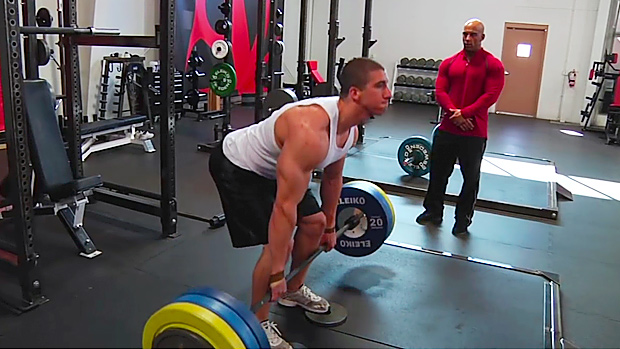Damn You, Visigoths!
A lot of lifters live in the world of low-range reps because they probably think that women will get all damp-pantied over how much weight they're using and imagine what a wonderful mate such a testosterone-ish man would be, especially when it comes time to attach the plow to his frame and furrow the fields after the mule got lame or when the Visigoths came down from the mountains to plunder their land.
Sure, keep on thinking that, Spartacus. Too bad women don't give a damn how much you lift. Instead, try lifting with some C-notes hanging out of your waistband. Men care too, but it's not pretty. They'll hate you if you lift light weights (pencilneck), hate you if you lift moderate weights (slacker), and hate you if you lift big weights (steroid-usin' SOB).
Given all the uncertainty about weights used and rep ranges, maybe we should determine rep ranges through scientific factors instead, even if they seem a little out of the mainstream.
Consider what T Nation contributor Jeffrey Stout, PhD, and his colleagues observed: They found that a program focused on lower-body hypertrophy (higher reps) and maximal strength for upper body (lower reps) stimulated greater strength and power gains in the upper body than doing high-intensity training for both the upper and lower body.
More simply, working the lower body with high-reps instead of low, heavy reps translated to bigger strength and power gains in the upper body.
Stout and company found 20 experienced lifters between ages 18 and 35 and split them into two training groups, the HI (high intensity) group and the MP (mixed high volume) group.
The HI group followed a high-intensity program for both upper and lower body (4-5 reps at 88% to 90% of the most amount of weight they could lift for one rep).
The MI group did high intensity work for just the upper body while doing high-volume training for lower body hypertrophy (10-12 reps at 65% to 70% of what they could do for one rep).
The researchers tested for strength and power before and after the 6-week training program.
What they found was some interesting stuff. The group that mixed typical hypertrophy-stimulating rep ranges for the lower body with high-intensity rep ranges for the upper body showed a whole lot more progress than the other group.
The mixed reps group got a lot stronger in the bench press than the other group. Their 1RM increased as did their lifting speed, i.e., their power. Additionally, the mixed protocol group experienced greater growth in their "arm muscle area" and greater reductions in fat mass, prompting the researchers to conclude:
"Results indicated the training programs focused on lower body muscle hypertrophy and maximal strength for upper body can stimulate greater strength and power gains in the upper body compared with HI resistance training programs for both the upper body and lower body."
Okay, so if you construct a training program based on heavy weight and low reps for the upper body and typical bodybuilding hypertrophy ranges (more than 10, for instance) for the lower body, you're going to give your upper body a significant boost.
This will result, according to this study, in a bigger bench press 1RM (through additional strength and power), additional biceps growth, increased loss of fat mass, and perhaps superior growth in the lower body, too.
Why these things are true is way open for speculation. Perhaps training lower body in higher rep ranges leads to additional growth hormone release that affects the entire body favorably. Or maybe training the lower body with heavy weights and low reps is systemically taxing and it drains resources from the upper body, stunting its growth.
Regardless, experimenting with this type of technique seems like a no-brainer since it can get you the best of many worlds: more strength, more power, and more size in the upper body and greater size in the lower body.
- Sandro Bartolomei; Jay R. Hoffman; Jeffrey R. Stout; Franco Merni, "Effect of Lower-Body Resistance Training on Upper-Body Strength Adaptation in Trained Men," Journal of Strength and Conditioning Research. 32(1):13–18, Jan 2018.





